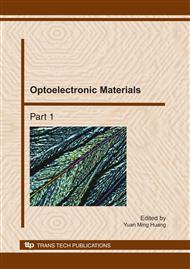[1]
J. W. Choi, C. Y. Kang, S. J. Yoon, H. J. Kim and H. J. Jung: J. Mater. Res. Vol. 14 (1999), p.3567.
Google Scholar
[1]
A. Nishitan, Y. Tsukamoto and S. Kanda et al, Anal. Chim. Acta Vol. 251 (1991), p.247.
Google Scholar
[2]
B. Yan, S. W. Lewis and P. J. Worsfold et al, Anal. Chim. Acta Vol. 250 (1991), p.145.
Google Scholar
[3]
P. J. Kwakman and U. A. Brinkman: Anal. Chim. Acta Vol. 266 (1992), p.175.
Google Scholar
[4]
A. R. Bowic, M. G. Sanders and P. J. Worsefold: J. Biolumin. Chemilumin. Vol. 11 (1996), p.61.
Google Scholar
[5]
C. Gooijer and M. Volthorst: Biomed. Chromatogr. Vol. 4 (1990), p.92.
Google Scholar
[6]
M. M. Nakamura, S. A. Saraiva and N. Coichev: Anal. Lett. Vol. 33 (2000), p.391.
Google Scholar
[7]
M. Shamsipur and M.J. Chaichi: Spectrochim. Acta A Vol. 57 (2001), p.2355.
Google Scholar
[8]
K. Nakashima, M. Wada and N. Kuroda et al, J. Liq. Chromatogr. Vol. 17 (1994), p.2111.
Google Scholar
[9]
M. Stigbrand, E. Ponten and K. Irgum: Anal. Chem. Vol. 66 (1994), p.1766.
Google Scholar
[10]
C. L. R. Catherall, T. F. Palmer and R. B. J. Cundall: J. Chem. Soc. Faraday Trans. Vol. 280 (1984), p.823.
Google Scholar
[11]
A. G. Hadd, A. L. Robinson and K. L. Rowlen et al, J. Org. Chem. Vol. 63 (1998) , p.3023.
Google Scholar
[12]
T. Wilson: Photochem. Photobiol. Vol. 62 (1995), p.601.
Google Scholar
[13]
S. Ahmed, S. Fujii and N. Kishikawa et al, J. Chromatogr. A Vol. 1133 (2006), p.76.
Google Scholar
[14]
M. Tsunoda, E. Uchino and K. Imai et al, Chromatogr. A Vol. 1164 (2007), p.162.
Google Scholar
[15]
M. Shamsipur and M. J. Chaichi: J. Photochem. Photobiol. A Vol. 155 (2003), p.69.
Google Scholar
[16]
M. Stigbrand, A. Karlsson and K. Irgum: Anal. Chem. Vol. 68 (1996), p.3945.
Google Scholar
[17]
M. Emteborg, K. Irgum and C. Gooijer et al, Anal. Chim. Acta Vol. 357 (1997), p.111.
Google Scholar
[18]
M. Shamsipur, A. Yeganeh-Faal and M. J. Chaichi et al, Dyes Pigments Vol. 72 (2007), p.113.
Google Scholar


